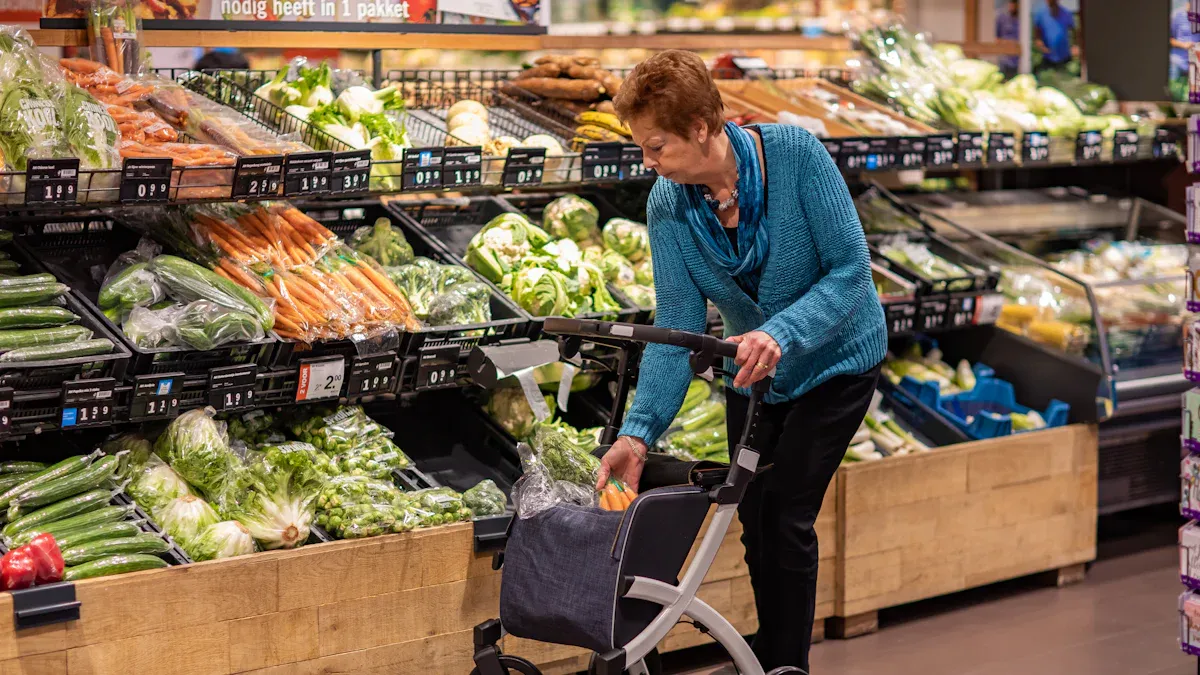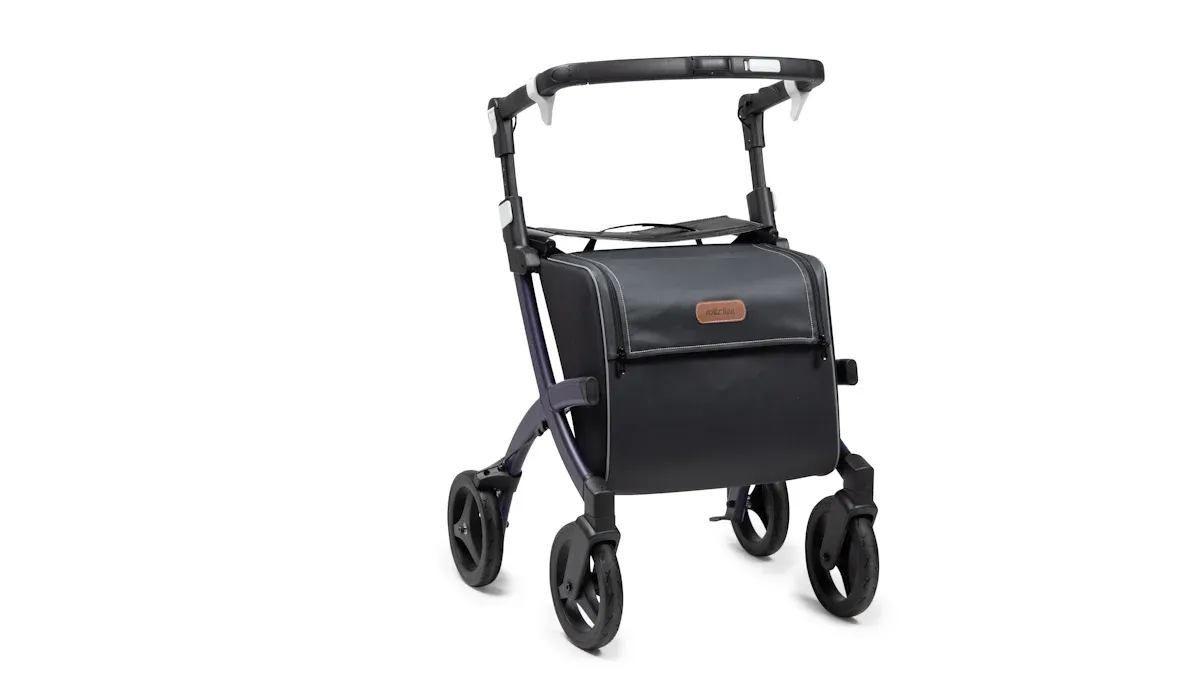Accessible Shopping Carts: Options and Features for Shoppers with Disabilities

Have you ever wondered how accessible shopping carts can change your shopping experience if you or someone you care for has a disability? Accessible shopping carts give individuals with disabilities the tools to shop with greater independence and comfort. These carts support accessible shopping by offering features that address mobility, sensory, and communication needs.
With about 28.7% of U.S. adults and 16% of people worldwide living with disabilities, accessibility in stores is not just helpful—it is essential. Accessible shopping helps both individuals with disabilities and caregivers enjoy a more inclusive and welcoming environment.
Key Takeaways
Accessible shopping carts offer features like adjustable handles, ergonomic designs, and wheelchair attachments to help shoppers with disabilities shop independently and comfortably.
Sensory aids such as visual markings, audio assistance, and tactile features make shopping safer and easier for people with visual or sensory impairments.
Motorized carts and built-in seats provide extra support for shoppers with limited mobility or those who need to rest during shopping trips.
E-commerce accessibility, including screen reader support and visual interpreter services, helps people with disabilities shop online with less frustration and more confidence.
Stores that train staff on accessibility and follow strong accessibility policies create a welcoming environment and improve the shopping experience for all customers.
Why Accessibility Matters
Inclusion and Independence
You deserve a shopping experience that feels welcoming and easy to navigate. Accessible shopping carts help you shop with confidence and independence. Many individuals with disabilities face challenges in stores, but accessible shopping features can change that. Research shows that only 15% of sensory-disabled shoppers feel satisfied with current accessibility options. Most stores focus on physical access, but they often overlook sensory and cognitive needs. Poor lighting, loud noises, and confusing layouts can make shopping stressful. When stores use tactile markers, Braille signage, and quiet zones, you can move through the aisles more comfortably.
Accessible shopping carts address physical barriers by offering lightweight and motorized options, so you can shop without needing extra help.
If you have a visual impairment, carts with audio navigation and Braille labels guide you safely.
Digital kiosks help you create shopping lists, making it easier to remember what you need.
Staff training on disability awareness helps create a more inclusive environment for everyone.
These features support accessible shopping and let you participate equally with other shoppers. You gain more control over your shopping experience, and you do not have to rely on others as much. Shopping cart accessibility gives you the freedom to shop at your own pace.
Overcoming Shopping Barriers
Traditional shopping carts often create obstacles for individuals with disabilities. The limitations of traditional shopping carts can make it hard to reach items, steer through narrow aisles, or carry heavy loads. Accessible shopping carts solve these problems by offering ergonomic designs and adjustable handles.
Many shoppers abandon their carts online due to privacy concerns, confusing layouts, or limited payment options. Research shows that understanding these barriers helps stores design better carts and checkout processes.
Accessible shopping and accessibility in stores and online help you complete your purchases with less stress. When stores address the limitations of traditional shopping carts, you enjoy a smoother shopping experience for individuals with disabilities.
Accessible Shopping Carts: Key Features

Ergonomic Designs
You benefit from ergonomic designs that make shopping easier and safer. Industrial studies show that ergonomic shopping carts reduce the risk of back injuries and muscle strain. These carts use lightweight materials and special handles to help you push and steer with less effort. Many user-friendly shopping carts include adjustable heights and textured grips, so you can keep a comfortable posture.
Ergonomic features help you avoid fatigue and make your shopping trip more enjoyable.
Design Feature | Ergonomic Benefit |
|---|---|
Lets you keep good posture and reduces tiredness. | |
Ergonomic Handles | Makes gripping easier and steering smoother. |
Lightweight Materials | Helps you move the cart with less effort. |
Customizable Shelves | Lets you organize items for easy access. |
When stores focus on optimizing shopping carts with ergonomic features, you experience better comfort and safety.
Adjustable Handles
Adjustable handles give you more control over your shopping cart. You can set the handle to a height that fits you best. This feature helps individuals with disabilities who may have different reach or strength levels. Adjustable handles also help seniors and children use the cart without straining their arms or backs.
You can shop longer and more comfortably when the cart fits your needs.
Wheelchair Attachments
Wheelchair attachments connect directly to your wheelchair, making shopping more accessible. These attachments let you move through the store without needing extra help. Specialized accessible shopping carts, like the Wheelchair Handy-Aid, support up to 400 pounds and fit many wheelchair types.
You can carry your groceries and personal items with ease.
Caregivers find it easier to assist without lifting or transferring you.
Wheelchair attachments address the limitations of traditional shopping carts by giving you independence and flexibility.
Motorized Carts
Motorized electric carts help you shop if you have limited mobility or strength. These carts come with easy-to-use controls and can turn in tight spaces. Some models offer trunk and head support for extra comfort.
Stores like Walmart now provide motorized carts in all locations, showing a strong commitment to accessibility.
You can shop at your own pace and carry heavier loads without worry.
Motorized carts improve shopping cart accessibility for individuals with disabilities and seniors who need extra support.
Double Baskets
Double basket designs give you more space and better organization. You can separate heavy items from fragile ones, making your trip safer and more efficient.
The market for double basket carts is growing fast, showing that more shoppers want this feature.
You can avoid basket overflow and reduce the number of trips needed.
Retailers see higher customer satisfaction and more spending when they offer double basket carts.
Double baskets help individuals with disabilities, caregivers, and multitasking shoppers manage their groceries with less stress.
Built-in Seats
Built-in seats allow you or your loved one to rest during shopping. Caroline's Cart is a great example. It has a large seat with a five-point harness and supports users from 35 to 250 pounds.
You can shop with your child or adult family member who cannot walk long distances.
The safety harness keeps users secure and comfortable.
Caregiver-friendly designs make it easier to assist without lifting.
Stores that offer built-in seat carts show they value accessibility and inclusion for all shoppers.
Accessible shopping carts with these key features support individuals with disabilities, seniors, and caregivers. They address the unique needs of each shopper and remove barriers that traditional carts create. When you choose stores that invest in accessibility, you enjoy a safer, more comfortable, and more independent shopping experience.
Sensory and Communication Aids

Visual Markings
You can find visual markings on many accessible shopping carts. These markings use bright colors, large fonts, or high-contrast labels. They help you spot important features on the cart, such as brakes, basket openings, or handle adjustments. If you have low vision, these markings make it easier to use the cart safely. Stores often place visual cues on the floor or shelves to guide you through the aisles.
Tip: Look for carts with bold stickers or colored handles. These features help you find what you need quickly.
A robotic shopping cart called RoboCart uses visual cues and barcode scanning to help you locate products. This technology shows how visual markings and smart design can support independent shopping for people with visual impairments.
Audio Assistance
Audio assistance gives you spoken instructions or alerts while you shop. Some carts use speakers to tell you when you reach a certain aisle or when you need to stop. If you have trouble seeing, audio cues can guide you to products or warn you about obstacles. RoboCart uses synthetic speech to help you find items and move around the store.
You can listen to directions instead of reading signs.
Audio alerts can remind you to check your list or pick up special items.
Audio features make shopping less stressful and help you stay safe.
Tactile Features
Tactile features use raised textures, Braille, or special grips. You can feel these features with your hands, which helps if you have low vision or are blind. Some carts have Braille labels on handles or baskets. Others use textured grips so you can hold the cart firmly.
Note: Tactile markers on carts and shelves help you find products without needing to see them.
Designers use feedback from people with disabilities to create better tactile aids. A recent review of assistive technology design shows that working with users helps match tactile features to real needs. This approach makes shopping carts more helpful for everyone.
E-Commerce Accessibility
Digital Shopping Tools
You can now shop online with more independence thanks to new digital shopping tools. Many e-commerce sites offer features like screen reader support, descriptive labels for buttons, and accessible error messages. These features help you find products, add them to your cart, and complete checkout pages with fewer barriers. Mobile apps also let you scan items, create lists, and get easy product modification options.
Smartphones have changed how you shop. You can plan your trip, navigate stores, and give feedback using your device. Studies show that 72% of accessibility bugs in digital retail affect screen readers. This means you need sites that work well with assistive technology. When you choose an accessible payment gateway, you avoid frustration at checkout pages.
Tip: Look for e-commerce sites that use clear labels and accessible error messages. These features help you fix mistakes quickly and finish your purchase.
E-commerce accessibility matters for everyone. About 13.4% of people in the U.S. face challenges shopping online because of accessibility barriers. Over 95% of popular e-commerce sites have issues like missing alt text or poor color contrast. When you shop on accessible sites, you enjoy inclusive digital experiences and better customer service.
Visual Interpreter Services
Visual interpreter services help you shop online and in stores. Services like Aira connect you with trained agents who guide you through e-commerce sites or physical aisles. You can ask questions, get help reading labels, or find products. This support makes checkout pages easier to use and helps you avoid mistakes.
Many e-commerce platforms now add visual interpreter options for shoppers with disabilities. These services improve accessibility and make shopping less stressful. You get real-time help, so you can shop with confidence.
Over 42.5 million people in the U.S. have disabilities, making e-commerce accessibility a top priority.
Legal rules like the ADA require e-commerce sites to be accessible.
Accessible e-commerce sites see more sales, loyal customers, and fewer lawsuits.
You deserve e-commerce accessibility that works for you. Choose sites that offer accessible error messages, clear checkout pages, and visual interpreter support. These features help you shop independently and safely.
Testing E-Commerce Accessibility
Testing e-commerce accessibility helps you make sure everyone can shop online with ease. You need to check both physical and digital shopping experiences often. This way, you can spot problems early and fix them before they affect your customers. Involving people with disabilities in the process gives you real feedback and helps you create better solutions.
Regular Accessibility Audits
You should use a mix of automated tools and manual checks to test your e-commerce site. Automated scanning tools can find many issues quickly, but they may miss some problems. Manual testing lets you see how real users interact with your site. Try these steps for comprehensive accessibility testing:
Test your site with keyboard-only navigation and screen readers like JAWS or VoiceOver.
Check your site at different zoom levels to make sure everything stays clear.
Set a regular schedule for audits, such as after every update or new feature.
Involve people with disabilities in your testing. Their feedback shows you what works and what needs improvement.
Keep records of your tests, issues found, and how you fixed them.
Track your progress with audit scores and user task completion rates.
Tip: Add accessibility checks to every stage of your e-commerce development, from design to checkout pages.
User Feedback
You can learn a lot by asking your shoppers for feedback. Use surveys, polls, or quick questionnaires with rating scales to measure satisfaction. Real-time tools like QR codes or tablets in stores help you collect feedback right away. Make sure your questions are clear and easy to answer.
Use Top-2-Box scores to compare customer feedback over time.
Try Consumer Satisfaction and Net Promoter Score to see how happy your shoppers are.
Look at Customer Effort Score to find out how easy it is to use your checkout pages.
When you gather feedback from people with disabilities, you get real insights into e-commerce accessibility. Their answers help you improve accessible error messages and other features. You can spot trends, track performance, and make your e-commerce site better for everyone.
Retailer Best Practices
Staff Training
You play a key role in making shopping easier for everyone. When you train your staff on accessible shopping carts and customer assistance, you help create a welcoming store. Staff who know how to help customers with disabilities can offer support without being pushy. Many customers notice when employees act open-minded, polite, and helpful. They appreciate when you offer help but also respect their independence.
Recent feedback shows that trained staff provide better service to shoppers with disabilities. Employees now show fewer reservations and give more thoughtful assistance. You can see this in stores where staff know how to use accessible carts and guide customers through the aisles. When you invest in staff training, you build trust and loyalty with your customers.
Tip: Hold regular training sessions and encourage your team to ask questions about accessibility. This helps everyone feel confident and ready to assist.
Accessibility Policies
You need strong accessibility policies to support all shoppers. The Americans with Disabilities Act (ADA) requires you to make your store accessible, both in person and online. Here are some important areas to focus on:
Make sure entrances have ramps or automatic doors.
Keep aisles at least 36 inches wide for easy movement.
Use clear signage for customers with visual or hearing disabilities.
Provide accessible checkout counters, parking, restrooms, and fitting rooms.
Add features like screen readers, high-contrast text, and closed captions to your website and digital kiosks.
If you do not follow these rules, you risk lawsuits, penalties, and losing customers. Many retailers, like Newegg, have improved their websites by adding screen readers and voice commands. These changes help more people shop with ease. Companies like Barclays and Microsoft have seen better customer satisfaction and a stronger brand by focusing on accessibility.
You should also conduct regular audits and ask shoppers for feedback. This helps you keep improving and shows that you care about optimizing shopping carts and the whole shopping experience for everyone.
Accessible shopping carts and digital tools help you shop with more comfort and independence. You see new trends shaping the way you shop:
Nearly 40% of U.S. internet users now use voice assistants for shopping.
Digital wallet use grew by 40% in two years.
44% of shoppers prefer chatbots for quick help.
Online ordering, curbside pickup, and contactless delivery have become common.
You can help create a better shopping world by supporting stores that offer these options. Ask for improvements and share your feedback. Together, you make shopping easier for everyone.
FAQ
What makes a shopping cart accessible?
You find accessible carts have features like adjustable handles, ergonomic designs, and wheelchair attachments. These features help you shop with more comfort and independence.
Can you request an accessible cart at any store?
You can ask for an accessible cart at most large retailers. Some smaller stores may not have them yet. Always check with customer service when you arrive.
How do motorized carts help shoppers with disabilities?
Motorized carts let you move around the store without needing to push. You control the speed and direction. This helps if you have limited strength or mobility.
Are accessible shopping carts safe for children with disabilities?
Yes! Many accessible carts, like Caroline’s Cart, have safety harnesses and built-in seats. These features keep children secure and comfortable during shopping trips.
What should you do if a store does not have accessible carts?
Ask staff if they can provide assistance.
Suggest the store add accessible carts.
Leave feedback online or in person.
Your feedback helps stores improve accessibility for everyone.
See Also
Understanding The Benefits And Issues Of Walgreens Self-Checkout
How Cloudpick Checkout Systems Improve Efficiency And User Experience
The Impact Of AI Tools On Managing E-Commerce Stores Today
